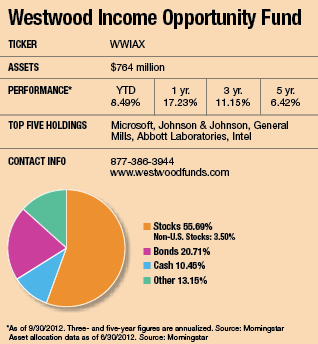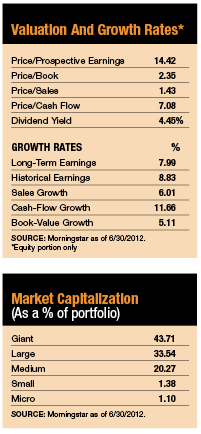As interest rates remain at rock-bottom levels, investors seeking higher yields are piling into bond funds. During the first seven months of 2012, those funds had seen net inflows (sales, adjusted for redemptions and exchanges) of more than $197 billion, while stock funds leaked more than $40 billion of investor money.

The mad dash to fixed-income securities worries Mark Freeman, manager of the Westwood Income Opportunity Fund. "I'm a little concerned about the timing of all these inflows," he says. "There are better income-producing investments out there."
As its name implies, the seven-year-old fund isn't tethered to bonds in its quest for yield. Instead, Freeman and his team diversify the income equation with eight asset classes that include dividend-paying stocks, bonds, master limited partnerships, preferred stocks and publicly traded real estate investment trusts.
Although the fund emphasizes a diversified income strategy, growth is also important here. "Our goal is to earn attractive total returns and maintain a low volatility profile," he says. "The fact that the securities in the portfolio offer high yields means we don't have to be overly aggressive on the growth side."
The combined yield of the securities in the fund currently clocks in at around 4%, near the low end of its historical 4% to 6% range. "If you add in some modest capital appreciation of 3% to 5% a year, that's an attractive total return," says the 44-year-old manager.
Freeman, who started his career as a fixed-income analyst, adjusts the fund's asset allocation to where he sees the best values, and these days bonds play a much less important role in the portfolio than they did in the past. According to the latest fact sheet, they account for just 21% of assets, whereas they made up half the fund at the end of 2008. Dividend-paying stocks account for 41% of the portfolio, after they accounted for only 11% four years ago. 
"Our allocation strategy is driven by where we are seeing opportunities, and just as important, where we do not," he says. "We believe income-producing stocks, particularly in the large-cap space, are offering the most attractive opportunities."
The shift away from bonds and the move toward dividend-paying blue chips began picking up speed a couple of years ago, when Freeman took note of the increasing number of companies whose dividend yields were higher than their 10-year corporate bonds. "To me, that was a clear indicator that informed professionals had a lot of faith in a company's creditworthiness," he says.
"At the same time, it was also a signal that the stocks were a better value than the bonds."
Freeman sees ample evidence that dividends will rise and stock prices will strengthen in the coming years. With the cash on corporate balance sheets near their historical highs, some companies have ample war chests to boost their dividend payments.
At the same time, payout ratios (the percentage of earnings paid as dividends) are near historic lows, an indicator that there's plenty of room for payout expansion. Companies have recognized the increasing importance of dividends to investors, and over the next 20 years that trend will continue as the number of people over age 65 seeking income-producing investments doubles.
The trends in executive compensation could also have a positive impact on stock prices. Twenty years ago, company managements were paid largely in stock options. Today, companies are more likely to dole out restricted stock, so managers have a vested interest in paying out and growing dividends over time.
Even if the favorable 15% tax rate on dividends expires next year, the demand for these payouts should remain solid, he says. Many dividend payers are held in tax-deferred accounts that won't be hurt by the tax increase, which would likely affect those earning more than $250,000 a year. And with large cash balances on corporate balance sheets, companies are in a good position to soothe some of the tax pain with rising dividend payouts. "With investor need for income and the ambiguous benefit share buybacks give to investors, dividend payouts would likely keep rising even with higher tax rates," he says. 
While rising interest rates could make bonds more attractive to new investors, Freeman points out that they usually signal a strengthening economy, which boosts dividends and stock prices. According to the firm's study of the last 40 years, dividend-paying stocks have actually outperformed their non-dividend counterparts during periods when inflation and interest rates rise.
Still, the stocks with some of the juiciest yields, such as utilities, aren't on his buy list. That's because they have a fairly high exposure to interest rate risk; investors tend to abandon them when interest rates rise and bonds look more appealing. Their dividend increases aren't as robust as some other companies', and the dividends also absorb most of their earnings.








